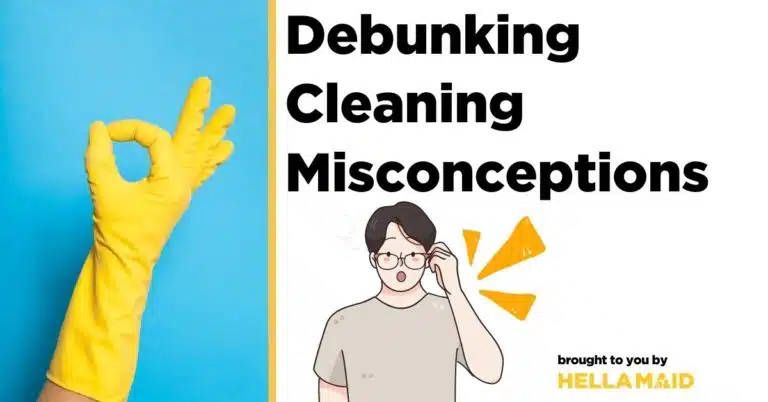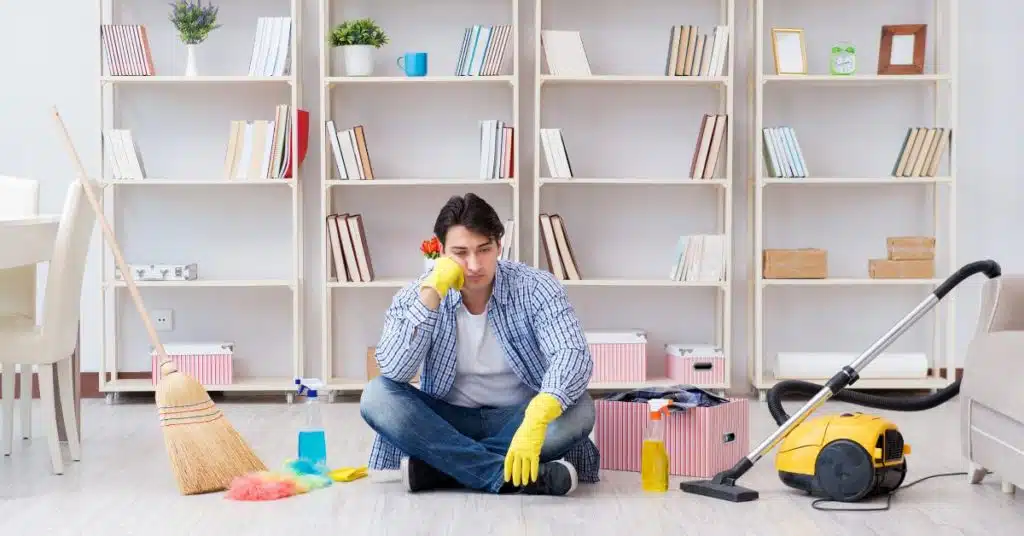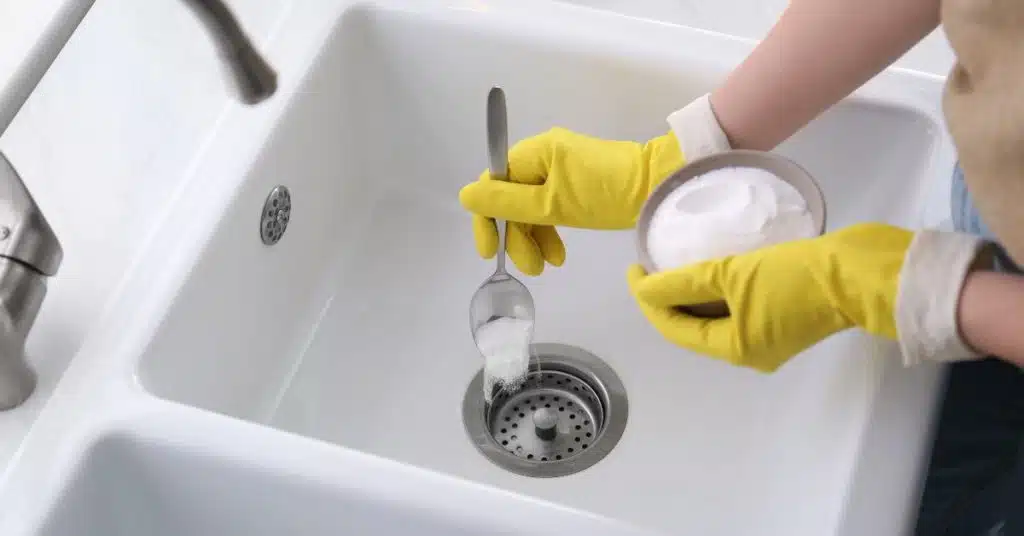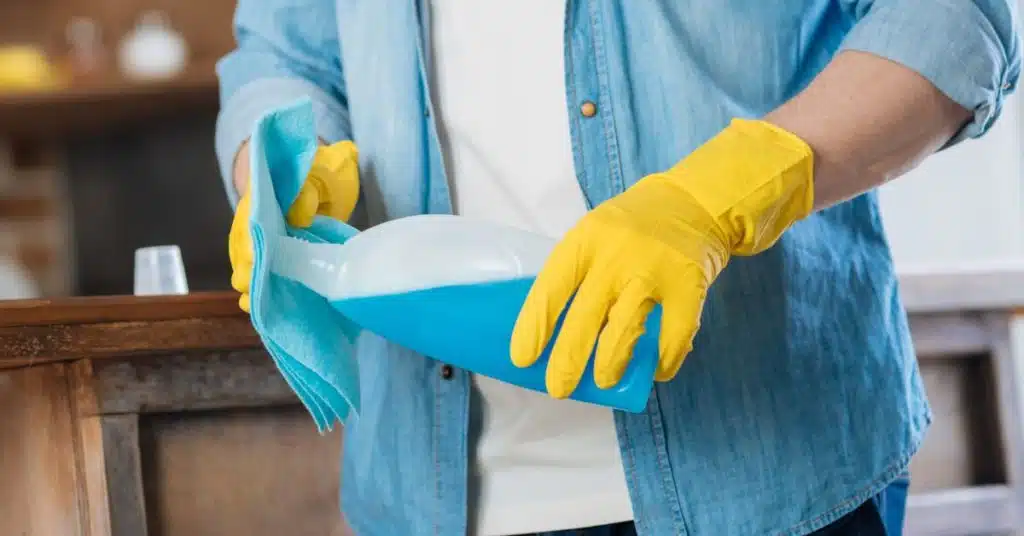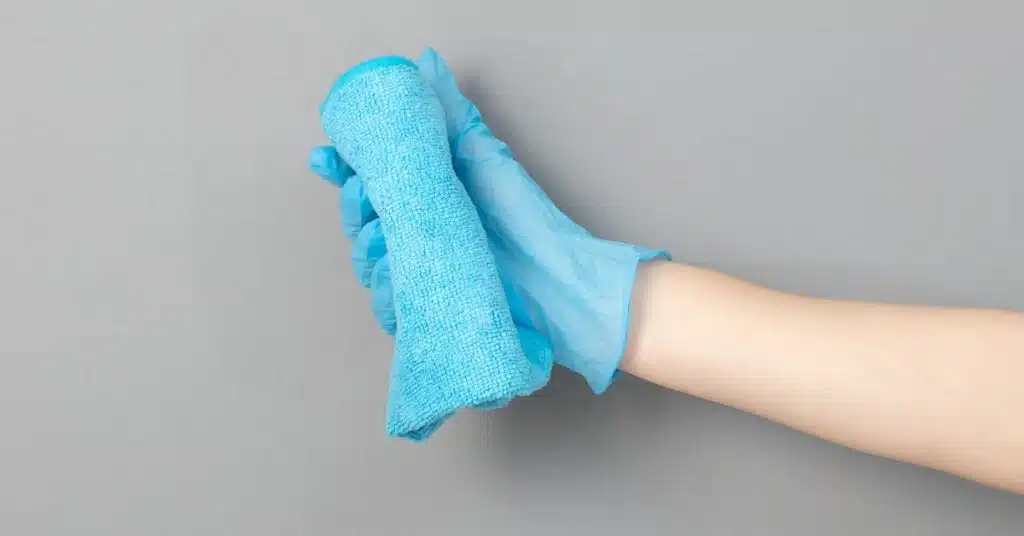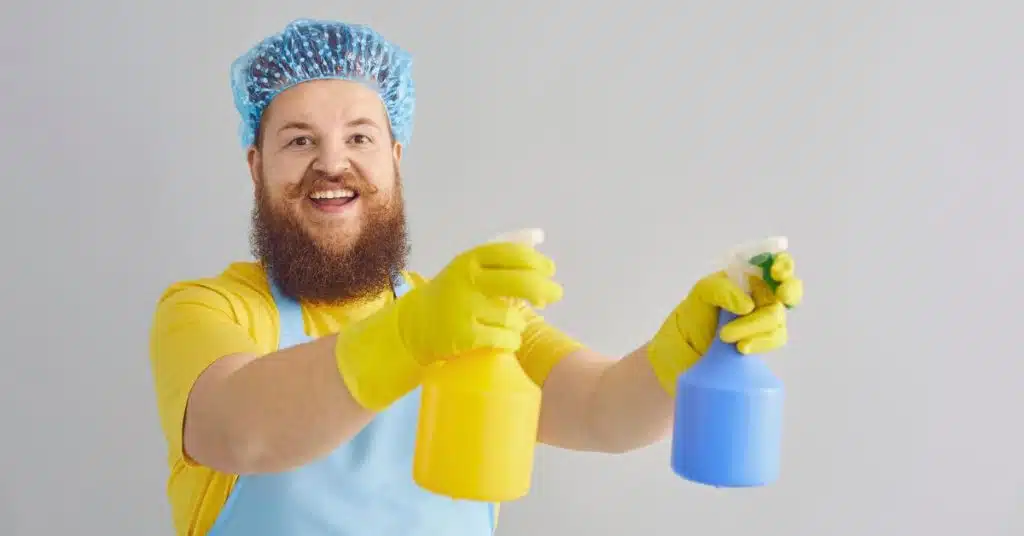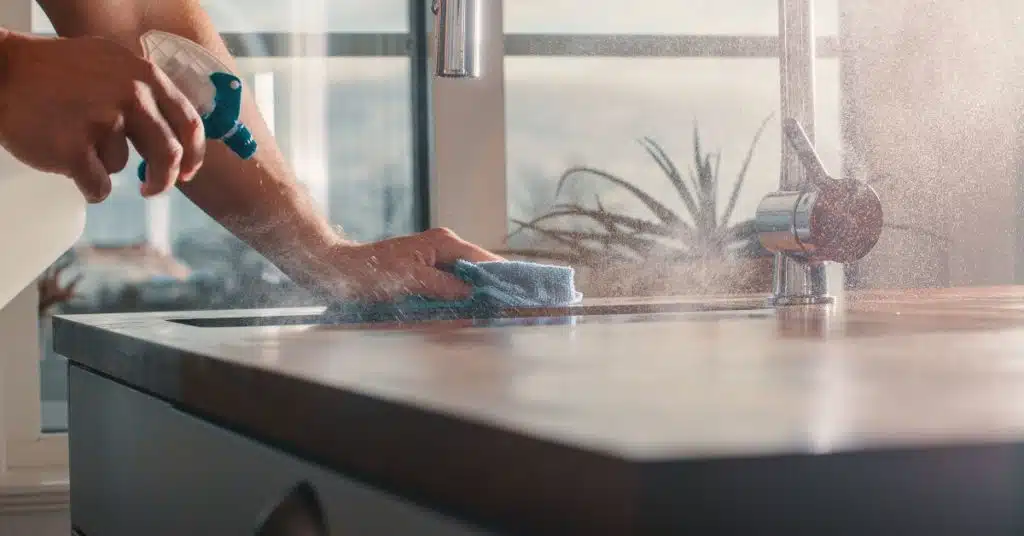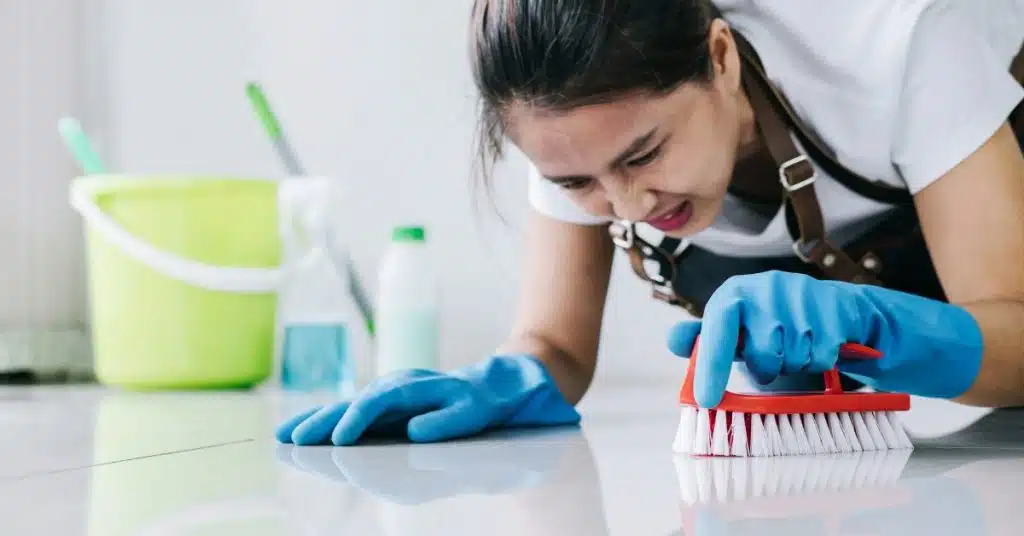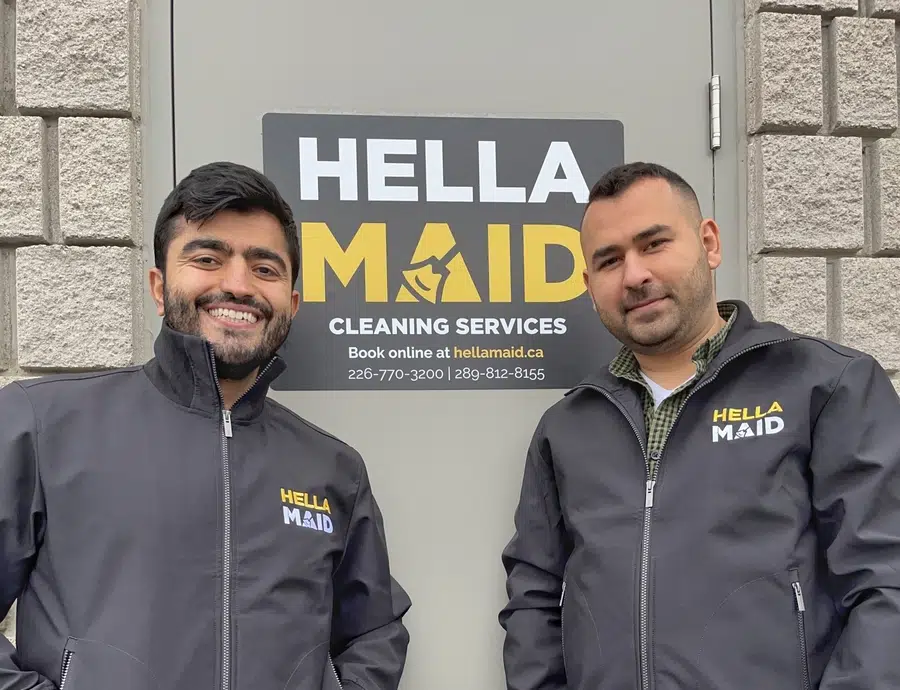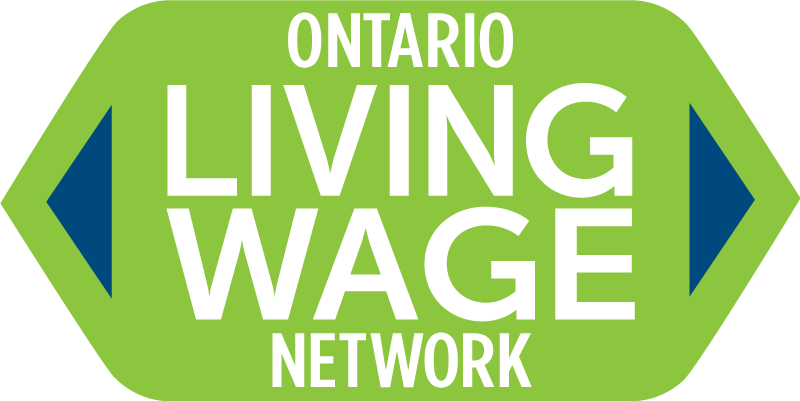Cleaning is an essential part of our daily lives, but it can also be a source of confusion, with numerous cleaning myths circulating around. These cleaning myths can lead us to adopt ineffective or even harmful cleaning practices, which is why it is essential to separate fact from fiction. In this article, we’ll debunk seven of the most common cleaning myths to help you get a clearer understanding of what really works.
Cleaning Myths: #1 White vinegar is a universal cleaner
White vinegar has long been touted as a universal cleaner, capable of removing stains, grease, and grime from various surfaces around the home. However, this belief is a common cleaning myth that needs to be debunked. While white vinegar is an effective and affordable cleaner for some surfaces, it is not suitable for cleaning all types of material, and in some cases, it can even cause damage.
White vinegar is an acidic cleaner with a pH level of 2.4. This makes it effective for removing mineral buildup, such as soap scum, on certain surfaces. It is also an effective degreaser, which makes it helpful in cleaning greasy stovetops and kitchen counters. However, the acidic nature of white vinegar can also cause damage to some surfaces, such as natural stone, wood, and certain types of metal. The acid can erode or discolor these surfaces, leaving behind unsightly marks.
White vinegar is not suitable for cleaning all surfaces, as its acidic nature can cause damage to some materials.
Here are a few examples of surfaces that should not be cleaned with vinegar:
Hardwood floors
The acid in vinegar can penetrate the finish of hardwood floors, causing discoloration and damage to the wood.
Stone surfaces
Stone surfaces, such as granite, marble, and travertine, are sensitive to acid and can be easily damaged by vinegar. The acid can etch the surface, leaving behind unsightly marks.
Metal surfaces
Certain types of metal, such as brass, bronze, and aluminum, can be discolored or corroded by the acid in vinegar. Make sure not to use pure vinegar; dilute it in water first.
Grout
Grout, which is a porous material, can be damaged by vinegar’s acidity, causing discoloration and weakening the structure of the grout.
Cast iron cookware
Cast iron cookware can be seasoned over time to build up a non-stick surface, and vinegar can remove this seasoning, leading to rust and damage to the cookware. If you still want to use vinegar to clean your cast iron cookware, make sure not to soak it for more than 8 hours.
Cleaning Myths: #2 Baking soda cleans everything
Baking soda is a versatile and affordable household item that has been promoted as a universal cleaner for years. That’s not true. Baking soda is not suitable for cleaning all types of surfaces; in some cases, it can cause damage.
Baking soda is an abrasive cleaner, making it effective for removing tough stains and grime from some surfaces, such as pots and pans, kitchen counters, and bathroom fixtures. Its abrasiveness also makes it useful for eliminating built-up grime from surfaces like the inside of an oven or refrigerator. However, the abrasiveness of baking soda can also cause damage to delicate surfaces, such as some types of metal, glass, and enameled surfaces. The abrasiveness can scratch or dull these surfaces, leaving them looking dull and damaged.
Another limitation of baking soda is its lack of disinfectant properties. While baking soda can effectively remove dirt and grime, it does not kill bacteria or viruses. For surfaces that require sanitizing, such as cutting boards, countertops, and bathroom fixtures, a disinfectant cleaner should be used.
Baking soda is an abrasive cleaner that makes it efficient for removing tough stains and grime from some surfaces. However, its abrasiveness can also cause damage to delicate surfaces.
Here are some examples of delicate surfaces that can be damaged by baking soda:
Delicate fabrics
Baking soda can cause damage to delicate fabrics, such as silk or lace, due to its abrasiveness. It can also leave behind a residue that is difficult to remove.
Enameled surfaces
Enameled surfaces, such as bathtubs and sinks, can be easily scratched by baking soda, causing deterioration and making them more sensitive to future damage.
Soft metals
Soft metals, such as aluminum or copper, can be easily scratched by baking soda, leading to discoloration and damage.
Delicate glass surfaces
Delicate glass surfaces, such as mirrors or polished glass, can be scratched by baking soda, causing damage and making them more susceptible to future damage.
Cleaning Myths: #3 The higher the concentration, the better
The belief that the higher the concentration of a cleaner, the better it works is another common cleaning myth. This notion is not always true, as a higher concentration of a cleaner does not always equate to a better or more effective cleaning solution. Using a cleaner with too high of a concentration can be harmful and even cause damage to surfaces.
Using a cleaner with a higher concentration than recommended can cause excessive suds, which can be difficult to rinse off and leave behind a residue that can attract dirt and grime. This can result in surfaces appearing dull and feeling slippery to the touch. In addition, using a cleaner with too high of a concentration can cause surface damage, such as discoloration, etching, or corrosion.
It is important to always check the manufacturer’s recommended concentration when using a cleaner, as this has been tested and determined to be the most effective and safe concentration for that specific cleaner. Using a cleaner with the correct concentration will not only produce the best cleaning results but also help protect surfaces from damage.
Here are five examples of common household cleaners and their recommended concentrations:
White vinegar
White vinegar can be used undiluted or diluted with water for cleaning, depending on the type of surface you are cleaning. A solution of equal parts water and white vinegar is recommended for most cleaning tasks, although a higher concentration of vinegar can be used for more challenging jobs.
Dish soap
Dish soap should be used according to the manufacturer’s instructions, typically requiring a small amount of soap added to warm water. Overusing dish soap can result in excessive suds, making it difficult to rinse the dishes thoroughly.
Laundry detergent
Laundry detergent should be used according to the manufacturer’s instructions, which will vary based on the size of the load and the type of detergent. Overusing laundry detergent can result in excessive sudsing and a residue that can cause skin irritation and static cling.
All-purpose cleaner
All-purpose cleaners should be used according to the manufacturer’s instructions, typically requiring a small amount of cleaner added to water. Overusing an all-purpose cleaner can result in excessive sudsing and a residue that can attract dirt and grime.
Toilet bowl cleaner
Toilet bowl cleaners should be used according to the manufacturer’s instructions, which typically call for a specific amount of cleaner to be added to the toilet bowl. Overusing a toilet bowl cleaner can damage the toilet bowl and excessive sudsing, making it difficult to flush the toilet. It is also important to avoid using a toilet bowl cleaner with a high concentration of chlorine, as this can cause damage to the toilet bowl and discoloration of the water.
Cleaning Myths: #4 Microfiber cloths are all you need
The cleaning myth that microfiber cloths are all you need to clean your home is not entirely accurate. Microfiber cloths are a great cleaning tool and can be used for various tasks, but they are not a one-size-fits-all solution.
One of the key advantages of microfiber cloths is that they are highly absorbent and can effectively trap dirt and grime. However, they are unsuitable for cleaning all surfaces and may not effectively remove certain types of dirt and stains. For example, they may not effectively remove grease and oil from surfaces such as stovetops and ovens.
Also, microfiber cloths should not be used for cleaning tasks requiring chemicals or bleach. Using a microfiber cloth with a cleaning solution that contains bleach or other harsh chemicals can cause the fibers to break down, reducing their effectiveness and lifespan.
Various cleaning tools and products, including sponges, brushes, and cleaning solutions, may be needed to effectively clean different surfaces and remove different types of dirt and stains. Using the right tool for the job is essential to get the best cleaning results.
Here are three cleaning tools that are best suited for specific cleaning tasks:
Scrub brushes
Scrub brushes are ideal for removing tough dirt and grime from surfaces such as bathtubs, showers, and tile. They can also scrub the grout, remove soap scum, and clean stovetops and ovens.
Sponges
Sponges are great for wiping down surfaces and cleaning up spills. They can also be used for scrubbing surfaces, but be sure to choose a sponge that is appropriate for the surface you are cleaning to avoid scratches.
Squeegees
Squeegees are perfect for cleaning windows and mirrors, as they can effectively remove streaks and smudges. They can also be used for removing water from shower doors and tiles.
Cleaning Myths: #5 Antibacterial cleaners are the most effective
While antibacterial cleaners can kill germs and bacteria, they may not be necessary for all cleaning situations. One of the main concerns with the widespread use of antibacterial cleaners is that they can contribute to the development of antibiotic-resistant bacteria. When bacteria are repeatedly exposed to antibacterial cleaners, they can become resistant to these agents, making it more difficult to kill them in the future.
Additionally, many common surfaces in the home, such as countertops and floors, do not require the use of antibacterial cleaners to be considered clean and hygienic. Regular cleaning with soap and water and proper ventilation and drying can be sufficient for many surfaces.
Even if antibacterial cleaners can be effective for particular cleaning tasks, remember that they are not always necessary and may even have some potential downsides. It’s essential to use the appropriate cleaning solution for each job, considering the surface being cleaned, the type of dirt and grime being removed, and the level of sanitation required.
Natural and non-toxic cleaning alternative to antibacterial cleaners:
Lemon juice
The acidic quality of lemon juice makes it a natural cleaning agent, especially for removing tough stains and grime.
Hydrogen peroxide
A natural alternative to bleach, hydrogen peroxide can be utilized to clean and disinfect surfaces. It can be mixed with water or used straight from the bottle.
Essential oils
Essential oils, like tea tree oil and lavender oil, can be used as a natural disinfectant and deodorizer. They can be added to a cleaning solution or used on their own.
Castile soap
Made from natural ingredients like olive oil, castile soap is a gentle and effective cleaning solution that can clean various surfaces, including skin and hair.
Club soda
Club soda can be used as a natural cleaning solution to remove tough stains from fabrics and carpets, such as red wine and coffee.
Salt
Salt can be used as a gentle abrasive for cleaning and scrubbing surfaces, such as grout and stovetops.
Borax
A natural mineral, borax can be used as a cleaning solution for removing stains and grime.
Cornstarch
Cornstarch can be used as a natural cleaning solution for removing grease and oil from surfaces such as stovetops and ovens.
Cleaning Myths: #6 Cleaning with hot water is more effective
Cleaning with hot water is a common myth passed down for generations. However, the belief that hot water is more effective for cleaning than cold water is only sometimes true. While hot water can be beneficial in some situations, it is not the most effective solution for all cleaning tasks.
One of the main benefits of hot water is that it can help to dissolve grease and grime more easily. This can make it an effective solution for cleaning kitchen surfaces, such as stovetops and ovens, where grease and food residue can accumulate. Hot water can also be effective for removing tough stains from fabrics and carpets.
However, hot water can also have some downsides. For one, hot water can damage certain surfaces, such as wood and certain types of plastic. It can also cause color fading and shrinkage in certain fabrics. Additionally, hot water can be a safety hazard, as it can cause burns if not handled properly.
When cleaning, cold water can be just as effective as hot water, primarily when used with other cleaning solutions, such as soap, detergent, or a cleaning spray. Cold water can also be more effective for cleaning certain surfaces, such as windows and mirrors, as it does not leave behind streaks and does not cause damage.
Safety considerations when using hot water for cleaning:
Burn risk
Hot water can cause burns if not handled properly. It is important to wear gloves and avoid direct contact with hot water, especially when cleaning with boiling water.
Slip and fall risk
When cleaning with hot water, the risk of slipping and falling on a wet surface can be increased. It is important to take precautions, such as using non-slip mats and being cautious when walking on wet surfaces.
Electrical safety
When using hot water for cleaning, it is important to be cautious of electrical appliances and outlets. Hot water and electrical equipment can be dangerous, so it is important to avoid using hot water near electrical outlets and to unplug appliances before cleaning.
Chemical reactions
Some cleaning products can react with hot water, producing hazardous fumes or chemicals. It is important to read the labels of cleaning products and to follow the manufacturer’s instructions carefully to avoid any dangerous reactions.
Water damage
Hot water can cause water damage to certain surfaces, such as wood or drywall. It is essential to avoid using hot water on delicate surfaces and to dry surfaces thoroughly after cleaning to prevent water damage.
Scalding
Hot water can cause scalding, mainly when used on sensitive skin. It is important to avoid using hot water on sensitive areas, such as the face, and to test the water’s temperature before cleaning it.
Cleaning Myths: #7 Scrubbing is the best way to clean
Scrubbing can be effective for removing certain dirt and stains, but it is not always the best or most efficient cleaning method. Scrubbing can be too harsh for some surfaces, causing damage or leaving behind scratches. For example, scrubbing a delicate or porous surface, such as a stone countertop or a glass shower door, with a stiff brush or abrasive sponge can scratch the surface and make it more susceptible to damage in the future.
In some cases, scrubbing can make the problem worse. For example, scrubbing a grease stain on a carpet can push the grease deeper into the fibers, making it harder to remove. Similarly, scrubbing a rust stain can cause the rust to spread and make the stain larger.
In other cases, other cleaning methods may be more effective than scrubbing. For example, soaking a greasy pan in hot soapy water can often loosen the grease, making it easier to clean without scrubbing. Similarly, using a cleaner designed to remove rust can be more effective than scrubbing a rust stain. It is essential to consider the type of dirt or stain being cleaned and choose the best cleaning method for each situation to avoid damaging surfaces and worsening the problem.
Alternative cleaning methods to scrubbing:
Soaking
Allowing an item to soak in a cleaning solution, such as hot soapy water, can often loosen dirt or stains, making them easier to clean without scrubbing.
Steaming
Using a steam cleaner can be an effective way to remove dirt and stains without scrubbing. The steam’s heat and moisture can help loosen dirt and make it easier to wipe away.
Blotting
Instead of scrubbing a stain, try gently blotting it using a clean cloth or sponge. This can help to lift the stain without damaging the surface.
Spraying
Using a spray cleaner can be an effective way to remove dirt and stains without scrubbing. Spray the cleaner on the affected area, allow it to sit for the recommended time, and then wipe it away.
Wiping
In many cases, simply wiping a surface with a clean, damp cloth can be enough to remove dirt and stains without the need for scrubbing.
In conclusion, cleaning myths can often be misleading and can lead to ineffective or even harmful cleaning practices. It’s important to educate ourselves on what really works and always to consider the safety and sustainability of our cleaning methods. By debunking these myths and learning the facts, we can achieve more effective and efficient cleaning results while also taking care of our homes and the environment. By combining different cleaning methods and tools and selecting the right cleaners for the job, we can achieve a cleaner and healthier home without resorting to harmful or ineffective practices.

